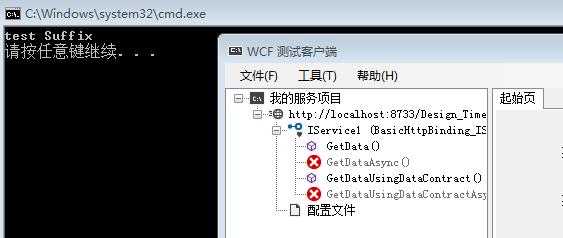WCF use ProtoBuf
Posted zhouandke
tags:
篇首语:本文由小常识网(cha138.com)小编为大家整理,主要介绍了WCF use ProtoBuf相关的知识,希望对你有一定的参考价值。
ProtoBuf, 比起xml和json, 传输的数据里面没有自描述标签, 而且是基于二进制的, 所以有着超高的传输效率, 据牛人张善友的描述, 可以替代WCF的自带的编码方案, 效率有极大的提升.
在网上搜罗了一遍, 很多博文都是复制张善友的文章, 有些细节没有说清楚, 所以将自己尝试的方法分享给大家.
1. 在VS2013中新建一个 WCF服务库, 名字使用默认的WcfServiceLibrary1
2. 在当前解决方案再新建一个Console程序, 名字叫Client
3. 使用nuget安装proto-net, 为什么不用最新的 2.1.0 版本呢? 因为要弹出错误 protobuf-net”已拥有为“NETStandard.Library”定义的依赖项。我估计应该是转.Net Core了, 没有继续研究了, 先用 2.0.0.668 吧
Install-Package protobuf-net -Version 2.0.0.668 -ProjectName WcfServiceLibrary1
Install-Package protobuf-net -Version 2.0.0.668 -ProjectName Client
将WcfServiceLibrary1\\packages\\protobuf-net.2.0.0.668\\lib\\net40\\protobuf-net.dll拷贝到
\\WcfServiceLibrary1\\WcfServiceLibrary1
WcfServiceLibrary1\\Client
4. 在服务端注册 行为扩展: 将下面的代码拷贝到<system.serviceModel>下面, 注册行为扩展的时候要求protobuf-net.dll就放在项目文件夹, 这就是第3步拷贝的原因
<extensions>
<behaviorExtensions>
<add name="protobuf" type="ProtoBuf.ServiceModel.ProtoBehaviorExtension, protobuf-net, Version=2.0.0.668, Culture=neutral, PublicKeyToken=257b51d87d2e4d67" />
</behaviorExtensions>
</extensions>
5. 在服务端将 行为扩展 应用在 终结点行为 上: 在<behaviors>下面拷贝
<endpointBehaviors>
<behavior name="protoEndpointBehavior">
<protobuf/>
</behavior>
</endpointBehaviors>
6. 还有就是让服务使用这个终结点行为, 在 <endpoint> 下添加
behaviorConfiguration="protoEndpointBehavior"
App.config最终样子
<?xml version="1.0" encoding="utf-8" ?>
<configuration>
<system.web>
<compilation debug="true" />
</system.web>
<system.serviceModel>
<extensions>
<behaviorExtensions>
<add name="protobuf" type="ProtoBuf.ServiceModel.ProtoBehaviorExtension, protobuf-net, Version=2.0.0.668, Culture=neutral, PublicKeyToken=257b51d87d2e4d67" />
</behaviorExtensions>
</extensions>
<services>
<service name="WcfServiceLibrary1.Service1">
<endpoint address="" behaviorConfiguration="protoEndpointBehavior"
binding="basicHttpBinding" contract="WcfServiceLibrary1.IService1">
<identity>
<dns value="localhost" />
</identity>
</endpoint>
<endpoint address="mex" binding="mexHttpBinding" contract="IMetadataExchange" />
<host>
<baseAddresses>
<add baseAddress="http://localhost:8733/Design_Time_Addresses/WcfServiceLibrary1/Service1/" />
</baseAddresses>
</host>
</service>
</services>
<behaviors>
<endpointBehaviors>
<behavior name="protoEndpointBehavior">
<protobuf/>
</behavior>
</endpointBehaviors>
<serviceBehaviors>
<behavior>
<serviceMetadata httpGetEnabled="True"/>
<serviceDebug includeExceptionDetailInFaults="False" />
</behavior>
</serviceBehaviors>
</behaviors>
</system.serviceModel>
</configuration>
7. 配置文件写好了后, 还需要修改IServer.cs, 这里只是简单例子, 就将 CompositeType 作为例子, 需要添加ProtoContract、ProtoMember 两种特性, 这样protobuf-net的编码器才能正确识别
[DataContract]
[ProtoContract]
public class CompositeType
{
bool boolValue = true;
string stringValue = "Hello ";
[DataMember]
[ProtoMember(1)]
public bool BoolValue
{
get { return boolValue; }
set { boolValue = value; }
}
[DataMember]
[ProtoMember(2)]
public string StringValue
{
get { return stringValue; }
set { stringValue = value; }
}
}
8. public interface IService1 还要要添加 [ServiceContract] 特性
9. 客户端引用WCF服务, 因为WCF服务就在本项目, 所以要选择 解决方案中的服务, 就命名为ServiceReference1吧
10. 客户端也要增加刚才的扩展和终结点行为, 这样客户端才能解析protobuf数据, 最终App.config 是这样的
<?xml version="1.0" encoding="utf-8" ?>
<configuration>
<system.serviceModel>
<extensions>
<behaviorExtensions>
<add name="protobuf" type="ProtoBuf.ServiceModel.ProtoBehaviorExtension, protobuf-net, Version=2.0.0.668, Culture=neutral, PublicKeyToken=257b51d87d2e4d67" />
</behaviorExtensions>
</extensions>
<bindings>
<basicHttpBinding>
<binding name="BasicHttpBinding_IService1" />
</basicHttpBinding>
</bindings>
<client>
<endpoint address="http://localhost:8733/Design_Time_Addresses/WcfServiceLibrary1/Service1/"
behaviorConfiguration="protoEndpointBehavior" binding="basicHttpBinding"
bindingConfiguration="BasicHttpBinding_IService1" contract="ServiceReference1.IService1"
name="BasicHttpBinding_IService1" />
</client>
<behaviors>
<endpointBehaviors>
<behavior name="protoEndpointBehavior">
<protobuf />
</behavior>
</endpointBehaviors>
</behaviors>
</system.serviceModel>
</configuration>
11. 将解决方案设置为双启动, 右键解决方案 --> 属性 --> 启动项目 --> 多启动项目
11. 好了, 可以在客户端调用服务了
static void Main(string[] args)
{
var proxy =new ServiceReference1.Service1Client();
var result=proxy.GetDataUsingDataContract(new ServiceReference1.CompositeType(){ StringValue="test });
Console.WriteLine(result.StringValue);
}
但是得到结果是null
12. 查看别人的博文 在Wcf中应用ProtoBuf替代默认的序列化器 , 原来protobuf 不是WCF的嫡出, 通过服务引用, 并不会像DataMember这种原生支持的Attribute那样, 把ProtoMember传输到Client的自动生成代码里, 所以还需要手工添加, 蛋疼啊
在打开的Reference.cs中找到属性 public bool BoolValue 添加 [ProtoMember(1)]
找到属性 public string StringValue 添加 [ProtoMember(2)]
这下终于有结果了
后记, protobuf 并不是为WCF准备的, 而是应该与 gRPC 配合使用, 在 gRPC 的示例文档中可以看到如将一个非常简单的 .proto文件编译成复杂的cs文件, 然后分别被服务端和客户端引用, 最终实现远程调用, 不过示例环境是VS2015
以上是关于WCF use ProtoBuf的主要内容,如果未能解决你的问题,请参考以下文章




